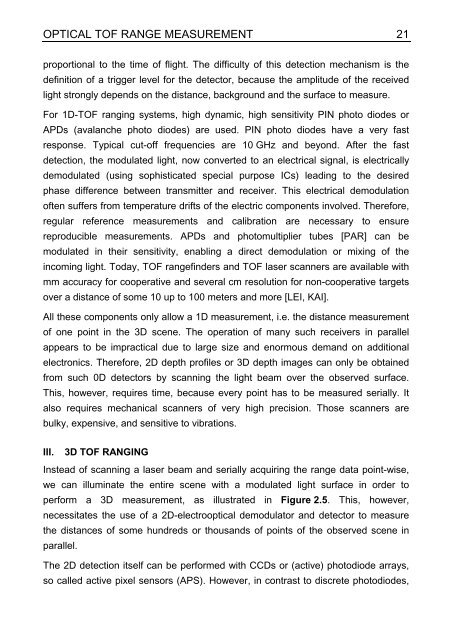3D Time-of-flight distance measurement with custom - Universität ...
3D Time-of-flight distance measurement with custom - Universität ...
3D Time-of-flight distance measurement with custom - Universität ...
You also want an ePaper? Increase the reach of your titles
YUMPU automatically turns print PDFs into web optimized ePapers that Google loves.
OPTICAL TOF RANGE MEASUREMENT 21<br />
proportional to the time <strong>of</strong> <strong>flight</strong>. The difficulty <strong>of</strong> this detection mechanism is the<br />
definition <strong>of</strong> a trigger level for the detector, because the amplitude <strong>of</strong> the received<br />
light strongly depends on the <strong>distance</strong>, background and the surface to measure.<br />
For 1D-TOF ranging systems, high dynamic, high sensitivity PIN photo diodes or<br />
APDs (avalanche photo diodes) are used. PIN photo diodes have a very fast<br />
response. Typical cut-<strong>of</strong>f frequencies are 10 GHz and beyond. After the fast<br />
detection, the modulated light, now converted to an electrical signal, is electrically<br />
demodulated (using sophisticated special purpose ICs) leading to the desired<br />
phase difference between transmitter and receiver. This electrical demodulation<br />
<strong>of</strong>ten suffers from temperature drifts <strong>of</strong> the electric components involved. Therefore,<br />
regular reference <strong>measurement</strong>s and calibration are necessary to ensure<br />
reproducible <strong>measurement</strong>s. APDs and photomultiplier tubes [PAR] can be<br />
modulated in their sensitivity, enabling a direct demodulation or mixing <strong>of</strong> the<br />
incoming light. Today, TOF rangefinders and TOF laser scanners are available <strong>with</strong><br />
mm accuracy for cooperative and several cm resolution for non-cooperative targets<br />
over a <strong>distance</strong> <strong>of</strong> some 10 up to 100 meters and more [LEI, KAI].<br />
All these components only allow a 1D <strong>measurement</strong>, i.e. the <strong>distance</strong> <strong>measurement</strong><br />
<strong>of</strong> one point in the <strong>3D</strong> scene. The operation <strong>of</strong> many such receivers in parallel<br />
appears to be impractical due to large size and enormous demand on additional<br />
electronics. Therefore, 2D depth pr<strong>of</strong>iles or <strong>3D</strong> depth images can only be obtained<br />
from such 0D detectors by scanning the light beam over the observed surface.<br />
This, however, requires time, because every point has to be measured serially. It<br />
also requires mechanical scanners <strong>of</strong> very high precision. Those scanners are<br />
bulky, expensive, and sensitive to vibrations.<br />
III. <strong>3D</strong> TOF RANGING<br />
Instead <strong>of</strong> scanning a laser beam and serially acquiring the range data point-wise,<br />
we can illuminate the entire scene <strong>with</strong> a modulated light surface in order to<br />
perform a <strong>3D</strong> <strong>measurement</strong>, as illustrated in Figure 2.5. This, however,<br />
necessitates the use <strong>of</strong> a 2D-electrooptical demodulator and detector to measure<br />
the <strong>distance</strong>s <strong>of</strong> some hundreds or thousands <strong>of</strong> points <strong>of</strong> the observed scene in<br />
parallel.<br />
The 2D detection itself can be performed <strong>with</strong> CCDs or (active) photodiode arrays,<br />
so called active pixel sensors (APS). However, in contrast to discrete photodiodes,

















